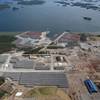APM Terminals Pipavav Starts New Ro/Ro Service
With 1,300 new Indian-built Ford automobiles loaded onto the Grand Dahlia on August 27th for delivery to Mexico, a new era for the Indian auto industry and Gujarat Port Pipavav commenced. The 59,217 gross ton roll on/roll off (Ro/Ro) vessel was the first to call Western India’s fastest-growing port, operated as part of the APM Terminals Global Terminal Network.
APM Terminals Pipavav announced the inauguration of Ro/Ro operations at the multi-purpose port last June after concluding an agreement with Japanese-based NYK subsidiary NYK Auto Logistics (NAL) India for finished car export services and the construction of a new automobile services terminal.
“This loaded shipment of Indian-built automobiles for export marks the beginning of not only a fourth new service offering to be provided by Port Pipavav, but also a new chapter in India’s growing automotive sector, and the new automotive manufacturing hub located in Gujarat State” noted APM Terminals Pipavav Managing Director, Keld Pedersen.
The 200-meter long, 33-meter wide Grand Dahlia, with a capacity of 6,500 vehicles, took on its cargo at the new NAL car terminal, which includes an 80,000 square meter (20 acre) automotive Ro/Ro stockyard, and a 4,400 square meter (one acre) staging area. The car terminal area is leased from Port Pipavav by NAL, which operates the facility and has the ability to process and load 250,000 vehicles annually. APM Terminals Pipavav also handles containers, dry bulk, and liquid bulk cargo operations, with direct double stack rail service to inland commercial and industrial centers.
The recently completed $1 billion Ford automobile and engine manufacturing facility in Sanand, Gujarat, approximately 300 km (186 miles) from Pipavav Port, has a production capacity of 240,000 cars and car engines each annually, with half destined for export. In the first 11 months of the fiscal year, Ford’s Indian automobile exports rose to 71,181m units, exceeding Ford’s domestic Indian car sales of 69,885 vehicles.
Also active in Gujarat State is the Ford Motor Company’s fellow US-based global rival General Motors, along with home-grown Indian-based Tata Motors. Japanese-based Suzuki Motors has announced the construction of a new auto manufacturing facility with an annual production capacity of 750,000 vehicles, projected to open in 2017. Gujarat thus joins the Delhi region and South India’s Bengaluru/Chennai corridor as India’s third automotive manufacturing cluster, and a new center of finished auto exports.
Ford’s global manufacturing strategy includes tripling exports of its Indian-built cars, including the Aspire model compact sedan marketed to other emerging economies. Indian passenger car exports have grown by 60% over the past five years, exceeding 620,000 in 2014, surpassing China’s passenger car exports of 533,000 passenger vehicles.
An expansion now underway will include strengthening the existing berth, additional dredging, three new post-Panamax cranes, and four RTGs, which will increase the port’s annual throughput capacity to 1.35 million TEUs. Pipavav is one of two facilities in India able to accommodate high-cube double-stack rail cars. In April 2014 a new liquid bulk terminal, operating under sub-lease by the Aegis Group, was officially opened. Container throughput at APM Terminals Pipavav was 780,000 TEUs in 2014, reflecting an annual growth rate of 18%, along with 3.13 million tons of bulk cargo.






